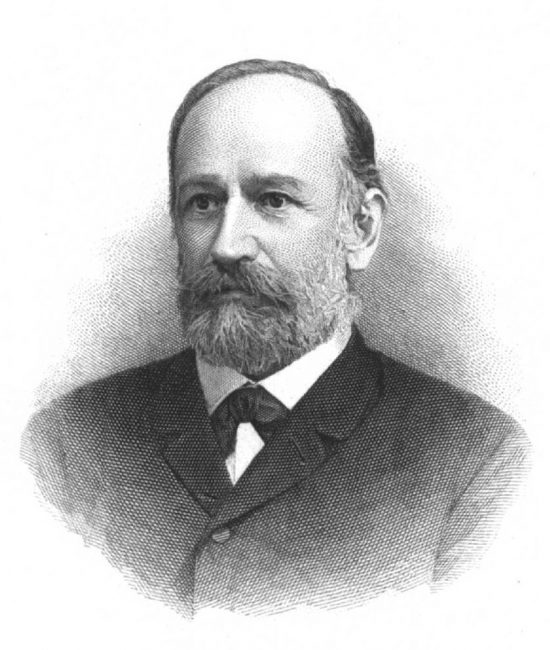
Josef Stefan (1835-1898)
On March 24, 1835, Carinthian Slovene physicist, mathematician, and poet Josef Stefan was born. Stefan is best known for originating Stefan’s law in 1879, a physical power law stating that the total radiation from a black body is proportional to the fourth power of its thermodynamic temperature T. As long as you are not a physicist specialized in black body radiation, you probably have never heard of Josef Stefan. For me as a computer scientist, it is even more unlikely to know him. But, more than 10 years ago, I met colleagues (and friends) from Slovenia, who are working at the Josef Stefan Institute in Ljubljana, Slovenia. Thus, it is high time, to include the namesake of this large research institute also in SciHi blog.
Early Years in the Austrian Empire
Josef Stefan was born near St. Peter (Slovene: Sveti Peter; today a district of Klagenfurt) in the Austrian Empire (now in Austria) into a family of ethnic Slovenes. His father was a milling assistant and mother served as a maidservant. They were both illiterate and were not married. He attended elementary school in Klagenfurt, where he showed his talent and was recommended to continue his education in Klagenfurt Lyceum in 1845. Stefan was interested in Slovenian and poetry. Together with friends he founded a Slovenian literary circle in which the members borrowed books from Slovenian and Slavic authors. After high school graduation, he briefly considered joining the Benedictine Order, but his great interest in physics prevailed. He left for Vienna in 1853 to study mathematics and physics at the University of Vienna. He graduated four years later with a degree in mathematics and physics.
Slovenian Poetry and Habilitation
Stefan continued to write Slovenian poetry and prose throughout his student years but after criticisms by the Slovenian literary experts, he gave this up around the time he graduated from the University of Vienna. For the next year he taught physics for pharmacy students, then accepted a position with Karl Ludwig at the Physiology Institute of Vienna University. Stefan then earned his habilitation in mathematical physics at the University of Vienna in 1858.[2]
Professor of Physics in Vienna
In 1859 he first took on a teaching position at a secondary school in Vienna. In 1863 he was appointed professor of physics at the University of Vienna and the sick director of the Physics Institute Andreas von Ettingshausen as deputy director, as well as in 1866 successor and director of the Institute of Physics. From 1875 to 1885 he was secretary of the mathematical-scientific class of the Academy of Sciences in Vienna, in 1883 president of the international scientific commission of the electrical exhibition and in 1885 president of the international vocal tone conference, which set the standard tone “a” at 435 Hertz.
Thermodynamic Temperature of a Black Body
Stefan published nearly 80 scientific articles, mostly in the Bulletins of the Vienna Academy of Sciences. He is best known for originating Stefan’s law (or Stefan–Boltzmann law) in 1879, a physical power law stating that the total radiation from a black body is proportional to the fourth power of its thermodynamic temperature T. The law was deduced by Stefan on the basis of experimental measurements made by John Tyndall [3] and was derived from theoretical considerations, using thermodynamics, by Stefan’s student Ludwig Boltzmann in 1884 [4]. Boltzmann considered a certain ideal heat engine with light as a working matter instead of a gas. The law is highly accurate only for ideal black objects, the perfect radiators, called black bodies; it works as a good approximation for most “grey” bodies. Stefan published this law in the article Über die Beziehung zwischen der Wärmestrahlung und der Temperatur (On the relationship between thermal radiation and temperature) in the Bulletins from the sessions of the Vienna Academy of Sciences.
The Sun’s Energy Flux
With his law Stefan also determined the temperature of the Sun’s surface. He learned from the data of Charles Soret that the energy flux density from the Sun is 29 times greater than the energy flux density of a certain warmed metal lamella (a thin plate). A round lamella was placed at such a distance from the measuring device that it would be seen at the same angle as the Sun. Soret estimated the temperature of the lamella to be approximately 1900 °C to 2000 °C. Stefan surmised that ⅓ of the energy flux from the Sun is absorbed by the Earth’s atmosphere, so he took for the correct Sun’s energy flux a value 3/2 times greater than Soret’s value, namely 29 × 3/2 = 43.5, which resulted in a temperature of 5,430 °C (9,810 °F). This was the first sensible value for the temperature of the Sun.
Further Achievements
Stefan provided the first measurements of the thermal conductivity of gases, treated evaporation, and among others studied diffusion, heat conduction in fluids. Very important are also his electromagnetic equations, defined in vector notation, and works in the kinetic theory of heat. Stefan was among the first physicists in Europe who fully understood Maxwell’s electromagnetic theory and one of the few outside England who expanded on it. He calculated inductivity of a coil with a quadratic cross-section, and he corrected Maxwell’s miscalculation. He also researched a phenomenon called the skin effect, where high-frequency electric current is greater on the surface of a conductor than in its interior.
Since 1878 he was a corresponding member of the Bavarian Academy of Sciences. In 1892 he was elected a foreign member of the Göttingen Academy of Sciences. Josef Stefan died in Vienna, on 7 January 1893, at age 57.
Gan Chang, 17. Solutions to Boltzmann Equation: Diffusion Laws, [7]
References and Further Reading:
- [1] Homepage of the Josef Stefan Institute, Ljubliana, Slovenia.
- [2] John J. O’Connor, Edmund F. Robertson: Josef Stefan. In: MacTutor History of Mathematics archive
- [3] John Tyndall and the Physics of Air, SciHi Blog, August 2, 2014.
- [4] Ludwig Boltzmann and Statistical Mechanics, SciHi Blog, February 20, 2014.
- [5] Josef Stefan at Wikidata
- [6] Extended biography of Josef Stefan, by John C. Crepeau
- [7] Gan Chang, 17. Solutions to Boltzmann Equation: Diffusion Laws, MIT 2.57 Nano-to-Micro Transport Processes, Spring 2012, MIT Open CourseWare @ youtube
- [8] Timeline of Slovenian Scientists, via DBpedia and Wikidata





